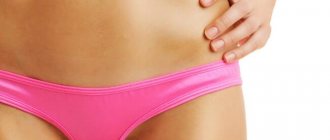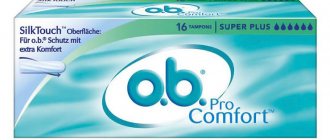Despite the fact that hygienic tampons have long been available to all women, “myths” are still created around them. For example, that with tampons, periods end faster.
When asked if it’s true that menstruation goes away faster with a tampon,
the women's site sympaty.net can give the only correct answer - it's not true. Not a single hygiene product can affect the course of periodic female bleeding.
But there are reasons why some girls may have the impression that due to the chosen hygiene products, the period of menstruation has changed less.
Are tampons harmful during menstruation?
High-quality tampons produced by reputable manufacturers can be used by all girls and women during their periods. Exceptions are made only for teenagers; during the period of the formation of the menstrual cycle, gynecologists advise girls to use pads.
Before you start using tampons, you need to find out what they are made of. You can safely use hygiene products made from cotton. If viscose was used in their manufacture, individual hypersensitivity reactions may occur. To improve absorption, various chemical compounds are added to viscose.
The harm of tampons for women during menstruation is obvious if they contain dioxin. It is a chemical used to impart a white color to materials used to make sanitary products. It has carcinogenic properties and suppresses the immune system.
Most people who talk about harm think about toxic shock syndrome. It occurs mainly when the recommended time frame for replacing hygiene products is not observed and the rules for using tampons during menstruation are violated.
How long is considered safe to wear tampons?
You should not keep a sanitary tampon inside the vagina for more than 6 hours. The ideal option would be to change it every 4 to 6 hours, depending on the amount of discharge. After childbirth, using tampons to absorb bloody discharge is not recommended. It is better to use pads for this purpose, the top layer of which is made of soft cotton. Many women are interested in the question of whether it is harmful to constantly wear tampons on “critical” days and whether it is possible to sleep with them. Gynecology has no contraindications for this, but some experts recommend alternating the use of pads and tampons. The main thing is not to allow the tampon to remain in the vagina for more than 8 hours. Sleeping with a tampon is very convenient because you don’t have to worry about getting your bed linen dirty if you move too much. In the morning, you need to remove it, toilet the external genitalia, and you can insert a new one, or use a pad. If removing the tampon is difficult, it means it is not saturated enough. There is only one recommendation here - to use tampons with a lower degree of absorbency.
How to put tampons during menstruation
Improper use of hygiene products can cause discomfort or pain in the lower abdomen and vaginal area. Therefore, before first use, it is advisable to read the instructions for use, which are included in each pack.
Before starting the procedure, you must thoroughly wash your hands with soap and print out the individual packaging containing the tampon. The mechanism for introducing a hygiene product will vary depending on the type chosen. They can be with or without an applicator.
With applicator
Having opened the package with the tampon, you need to inspect it. It should be inserted with the rounded side up, the end of the sewn rope should look out of the vagina.
Instructions for using tampons with an applicator during menstruation:
- the woman needs to position herself so that it is convenient to insert the applicator - one leg can be placed higher than the other, for example, on the toilet, the edge of the bathtub or a chair;
- the labia and the entrance to the vagina need to be spread apart with one hand, and with the other, take the applicator in the place where its 2 parts connect;
- Having inserted the upper part of the applicator into the vagina (it is enough to insert it to a depth of 4 cm), you need to press on its lower part, holding the place of their connection with the other hand;
- After inserting the tampon, the applicator is removed.
It is advisable to make sure that the cord is sticking out of the vagina. You will need it to remove the hygiene device.
Without applicator
The procedure for installing a tampon without an applicator during menstruation is slightly different:
- after unpacking, you need to check the reliability of the thread, it should be straightened and tensioned;
- your legs should be spread apart, placing one of them higher, you can spread them wide while sitting on the toilet;
- With one hand you need to take the tampon from the side where the thread is located, with the other, spread the labia, the entrance to the vagina;
- The tampon is inserted inside with your finger; you need to press on the indentation made at its base;
- The recommended immersion depth does not exceed the length of the index finger.
It is most convenient to introduce the hygiene product at an angle of 45° to the spine. If a feeling of pain or resistance appears, it is necessary to slightly change the direction of its introduction.
Rules for inserting tampons
Tampons are a convenient hygienic product that saves girls and women from wearing uncomfortable pads during menstruation. They were invented precisely for these purposes, and it is not recommended to wear them during the intermenstrual period. To ensure that using tampons does not cause discomfort, they should be selected according to their absorbency. This selection criterion is determined by the number of droplets indicated on the packaging. Therefore, on different days of menstruation, you should use appropriate tampons (the more drops on the package, the more discharge the tampon can absorb). Even virgins can use tampons because they easily penetrate the vagina through the hole in the hymen. Hygiene products with an applicator are very convenient to use. To insert them, a squatting position will be comfortable. Next, one tampon is removed from the package and, holding it with the thumb and middle finger, the rounded end is brought to the entrance to the vagina. Then, with a slight movement of your index finger, press the applicator from above, similar to using a syringe. If the tampon is inserted correctly, it will be inside the vagina at a sufficient depth, the applicator will slide out, and only a thread will remain, which will later be needed for removal. To insert a tampon without an applicator, its rounded end should be inserted into the vagina and pushed away with your finger until it rests on the cervix. This is easily determined, since the tampon can no longer move further.
How to wear tampons during your period
Women who choose tampons should know how to use them correctly. They can be introduced starting from the first day of menstruation.
- the tampon must be inserted to a comfortable depth - it should not be felt in the vagina;
- in cases where the tampon is not completely saturated within a period of up to 6 hours, you should pay attention to varieties with a lower degree of absorption;
- when replacing, it is important to wash your hands before and after insertion;
- To prevent the development of toxic shock syndrome and other complications, you can alternate them with pads.
If you experience a feeling of dryness or irritation when using tampons, then it is better to discard them. They are not recommended for women during the course of treatment with vaginal suppositories and tablets. Due to their absorbent properties, the effectiveness of therapy may be reduced.
Why did my period end with a tampon 2 days earlier and cause discomfort?
It is best to use tampons at the very beginning of your period, when your flow is very heavy and there is a lot of blood coming out. Thus, the product absorbs blood, but the mucus on the walls remains intact. If the saturation is quite abundant, removing the tampon is quite simple. It does not slip out of the vagina, but it is quite easy to pull it out. It is enough to apply a little effort by pulling the cord. The opposite situation occurs if a woman has chosen the wrong hygiene product, and during use the tampon is difficult to remove, despite using it for 6-8 hours.
Why did my period end with a tampon 2 days earlier?
- The tampon absorbs not only discharge from the uterus in the form of blood, but also vaginal secretions. This can negatively affect a woman's health. After all, mucus contains microorganisms that help maintain a woman’s health.
- This mucus contains a large number of lactobacilli that prevent the development of the disease and suppress the growth of opportunistic microflora, such as candida fungi, staphylococci and other opportunistic microorganisms that are present in all women.
- If you often use tampons at the end of your period, when the discharge is not very heavy, then there is a risk of gynecological ailments. Dysbacteriosis, vaginitis, and candidiasis may occur.
- This is often observed in women who use tampons that are inappropriate for the amount of discharge. Accordingly, it is best to purchase tampons that absorb less and change them more often than to save money by using tampons with the highest absorbency when the discharge is scanty. It is these women who are at risk for developing toxic shock syndrome.
Hygiene products
How often to change a tampon during menstruation
The rules for using all hygiene devices during menstruation are the same. Like pads, it is advisable to change them between 2 and 8 hours.
Duration of use is directly related to the intensity of menstruation. In the first days, experts recommend taking types with a high degree of absorption. They should be changed every 3-6 hours. In the last days of your period, it is better to focus on the types marked with 2 drops. The use time can be extended up to 8 hours.
How many tampons per day is normal during menstruation?
Women who use only tampons can change them more than 6 times a day in the first days of their period. For the night, many manufacturers produce special options with maximum absorbency. To be on the safe side, women who sleep soundly can additionally use a pad.
By the end of menstruation, their number can be reduced to 3-4 pieces. But gynecologists advise alternating their use with pads.
How long does a tampon last for heavy periods?
Women with heavy discharge are recommended to use types marked “super plus” or “ultra”; an icon with 5 drops should be placed on the packaging. This marking means that 1 tampon absorbs from 15 to 18 g of menstrual blood.
In case of heavy discharge, the specified hygiene product should be completely filled within 2-3 hours. If it becomes full in less than an hour, it is better to consult a gynecologist.
Do tampons affect the amount of menstrual flow?
Sometimes women note that when using them, periodic discharge is scanty - the volume of blood flowing out is less.
But it only seems so. The fact is that a tampon completely absorbs liquid, and if you change tampons in a timely manner, it is impossible to “by eye” assess the abundance of natural bleeding. It seems that there is not that much discharge if it is completely absorbed into such a small object. But with a pad, it may seem like there is more blood - since it is smeared on the surface of the pad. Also, the illusion of excessively heavy periods can be created by a menstrual cup - since all the leaked blood accumulates inside it.
The design of the menstrual cup gives the erroneous impression of heavy bleeding
In addition, there are subjective sensations familiar to all women. So, when using pads, a woman feels the moment a portion of blood flows out - this is natural and should not be scary. And if a tampon is inserted into the vagina, then this moment is not felt - after all, all the discharge is immediately absorbed.
Therefore, it may seem that the intensity of discharge changes due to the use of one or another hygiene product.
If you use only tampons for a long time, or alternate the use of different products, you will notice that the cycle does not undergo any significant changes.
In fact, the course of menstruation cannot be affected by an object located in the vagina and absorbing the fluid that has already flowed out.
The intensity and duration of this condition in women is determined by her hormonal levels, physical activity and, in some cases, existing diseases and pathologies.
It is impossible to “correct” periods using tampons in any way.
How to extract correctly
To remove the tampon, you simply pull the string that protrudes from the vagina. When sufficiently full, it comes out easily. If a feeling of resistance appears, you can postpone the procedure.
In cases where the rope cannot be found, you need to squat down (toilet) and tense your pelvic muscles as if you are having a bowel movement. In this case, the cylinder filled with menstrual blood will have to go down a little. You can pull it out by grabbing the bottom with your fingers. If you can’t do this yourself, you need to consult a gynecologist.
Why does a sanitary product seem to affect the length of your period?
A familiar feeling to some women is that with a tampon, your period ends faster. But this is not entirely true - these hygiene products do not shorten the duration of menstruation, but rather make the period of its end unnoticeable.
Feminine hygiene products cannot affect the duration and abundance of discharge
So, sometimes it seems that your period has stopped after a tampon. Reason: on the penultimate or last day of menstruation, when the blood gives way to “smudges”, the discharge does not occur constantly “drop by drop”, but once every few hours.
What to choose - tampons, pads? Let's discuss it here >>
For example, if a woman suddenly stands up or, conversely, sits down. And when using a tampon, all the released blood or “smear” is immediately absorbed, and then you can even remove the tampon and there will be no discharge for some time. But if you use a pad, thick discharge or a small portion of blood may leak onto it gradually, making it seem like your period is still active.
And in no case can one say that it was after the tampon that periods stopped coming at all.
If the next menstruation does not come on time or is absent, no hygiene products can be to blame for this - this indicates either pregnancy or some abnormalities in the functioning of the body.
In any case, you should consult a gynecologist, and not hope to restore your cycle by returning to pads or a menstrual cup.
Website www.sympaty.net – Beautiful and Successful. Author – Daria Blinova. The article was checked by a practicing family doctor, Elizaveta Anatolyevna Krizhanovskaya, work experience - 5 years. More information about the site's authors
Why do my periods end faster with tampons?
Some women note that their periods are shorter with tampons. A decrease in their duration is associated with hormonal levels, genetic predisposition, and characteristics of the body. The type of hygiene products used cannot affect the duration of menstruation.
There may be a slight reduction in the duration of menstruation due to the fact that it takes less time to absorb blood from the uterus into the vagina than for it to come out. This is the reason for the emergence of the opinion that if you use tampons, your periods will go by faster.
Benefits of tampons
A tampon is an excellent hygiene product that was used in ancient Egypt. However, then women did not roll cotton wool at all, but pieces of wool. It is worth noting that since then their design and methods of administration have changed significantly. Many companies are ready to experiment and produce tampons with cardboard inserts and tubes that imitate the design of a syringe, and allow the hygiene product to be inserted as deeply as possible, without putting your hands inside the vagina. After all, contact between mucous membranes and the surface of hands that are poorly washed can lead to infection. Let us note that there are a lot of legends and rumors associated with tampons that are not true.
Benefits of tampons:
- However, in fact, blood is a favorable environment for the development and reproduction of pathogenic and opportunistic microorganisms. This is what causes the unpleasant odor of pads that are not changed for more than 4 hours. Most often, the smell is observed in the hot season, when the temperature of the body and the surrounding air is quite high. Accordingly, bacteria develop faster, and the smell becomes a frequent companion for women who have their periods.
- In addition, many noted that using pads is less inconvenient; this prevents them from wearing tight clothes, so they use tampons from time to time. Such personal hygiene products help absorb blood directly inside the vagina, without it leaking out. However, this does not mean that microbes do not develop.
- In fact, the blood still becomes an excellent breeding ground for microorganisms, but their growth occurs not outside, but inside the body. That is why the use of one tampon is limited to no more than 8 hours. This time is critical. Accordingly, you cannot use tampons for 12 or 15 hours.
Menstruation
Rating of tampons for menstruation
When choosing the most suitable hygiene products to be used during menstruation, women are interested in hearing the opinion of professionals. The following brands are included in the ranking of the best:
When assessing, experts evaluate the degree of absorption, ease of use (determined by the presence of an applicator), price, composition, shape, presence of fragrances and chemical additives.
Each brand has several varieties of tampons, which are available in different price categories. The most popular are Tampax, ob and Kotex.
Doctors' recommendations
Opinions among gynecologists regarding the use of vaginal tampons during menstruation vary. Some doctors say they are harmless, provided the rules of use and frequency of replacement are followed. Others recommend using them only in exceptional cases when gaskets would be inappropriate.
Doctors advise not to wait 8 hours to change hygiene products. During this period, pathogenic microorganisms can multiply and lead to a deterioration in reproductive health. Some claim that their use can cause endometriosis, inflammatory diseases, and erosive lesions.
Most gynecologists recommend making sure there are no diseases of the reproductive system before starting regular use of tampons. It is necessary to refuse to use these hygiene products if there are contraindications.
Pads or tampons?
Women all over the world are divided into two camps (besides blondes and brunettes): tampon lovers and pad lovers. Progress is on the side of the former, experience is on the side of the latter, and each camp passionately defends its rightness. If everything is more or less clear with pads, and one can argue mainly about their convenience, then tampons cause a lot of fears, assumptions, and rumors. How valid are they?
Horrible
The main source of scary stories about tampons are forums on women's websites, where the most incredible versions exist:
- inserting a tampon is fraught with fainting, and for virgins - loss of innocence;
- the use of tampons by teenagers leads to masturbation and promiscuity;
- men don't respect girls who use tampons;
- A tampon is an excellent contraceptive.
Advanced tampon opponents prefer to use medical arguments, arguing that:
- cervical erosion, endometriosis, and inflammatory diseases of the pelvic organs are direct consequences of the use of tampons;
- tampons are impregnated with adsorbing chemicals that corrode the mucous membrane;
- a tampon clogs the vagina like a plug, preventing the outflow of blood;
- Using tampons increases the risk of contracting sexually transmitted diseases and can cause problems with conception.
It is noteworthy that most of these statements do not stand up to criticism and are ridiculous due to their obvious illiteracy. But what exactly are tampons? What are the risks of using them, and how can you protect yourself from this?
The first tampons: how it all began
The first tampons, similar to modern ones, were created in the early 30s of the last century by the American doctor Earl Haas, presumably at the suggestion of his wife. The invention was cotton wool wrapped in gauze. The product was named Tampax (from the English tampon and pack - tampon and packaging). The first tampons had neither an applicator nor a string. The fate of the new product initially turned out to be sad: the American monster Johnson & Johnson was not interested in it, and the patent was sold externally. Industrial production of tampons began in 1936. Now the owner of the Tampax trademark is Procter & Gamble, and Johnson & Johnson has been promoting an alternative brand of “ob” tampons since 1950.
Over the past 70 years, tampons have been improved, although they have not fundamentally changed. There were: a lace sewn into the tampon, an applicator, and a silky top layer that facilitated insertion. Tampons began to be divided into degrees of absorbency - mini, normal, super, super-plus. The essence remains the same: a tampon is made from a mixture of specially processed and bleached natural fibers - cotton and viscose, pressed into a cylinder of a certain density. There are no chemical ingredients in tampons. In contrast, by the way, to pads filled with substances that convert liquid into gel and can cause irritation of the mucous membrane upon direct contact.
Tampons - how they are
A lot of research has been conducted on the topic of identifying the potential danger of tampons, both paid for by manufacturing companies and independent, including commissioned by regulatory and certification bodies in Russia and abroad. Ultimately it was proven that when used correctly:
- tampons do not interfere with the outflow of menstrual blood and cannot create a plug effect - when the tampon is completely saturated, blood seeps through it and flows out freely;
- tampons do not cause changes in the vaginal microflora and an increase in the number of bacteria - changes in the composition of the vaginal environment are associated with menstruation itself; the composition of the tampon (cotton, viscose or a combination of both) also does not affect the vaginal microflora;
- tampons do not lead to rupture of the hymen - the hole for the outflow of blood in it is large enough (about 1.5 cm) and the hymen itself is quite elastic during menstruation. By absorbing moisture, the tampon mainly increases in length and, when removed, also cannot lead to loss of virginity;
- tampons do not cause “bad” sexual habits (if inserted correctly, the tampon is located in the receptor-poor area of the vagina and is not felt at all, i.e. physically cannot become a provocateur of erotic sensations);
- tampons do not cause endometriosis, cervical erosion, infertility and do not affect the duration of the cycle and menstruation itself - firstly, the vagina is highly adaptable and can “get along” even with a penis, the size of which is at least several times larger than the size of a tampon; secondly, the tampon does not come into direct contact with the uterus, which also adapts well and is quite well protected; thirdly, the duration of the cycle depends on the woman’s physiology, her hormonal levels, body structure, health status, weight and other internal factors, and not at all on whether a small cotton ball is inserted into the vagina for several hours;
- tampons cannot get into the uterus themselves, get stuck in the body forever or “get lost” - with a slight muscular effort (preferably while sitting on the toilet), a tampon inserted too deeply (if it is soaked in discharge) will come out on its own, even if its lace comes off, which , by the way, is also practically impossible, because The lace can withstand loads of up to 5 kg and is firmly sewn into the tampon along its entire length.
My periods stopped coming after the tampon
Even 20 years ago, tampons and periods were talked about bashfully, so that no one would hear. Now this product can be found in pharmacies and on store shelves. Everyone knows what they look like, but not everyone knows how to use them correctly.
Answering the question about why tampons are harmful during menstrual periods, it is worth noting the dishonesty of some manufacturers. A hygiene product is sometimes impregnated with various liquids to give it color, smell or desired properties. These substances can have a bad effect on the vaginal microflora, which leads to certain negative consequences.
The harm comes more from the manufacturer who decided to save on production. Modern tampons for menstruation are often impregnated with various essential oils and other plant components to which a woman may be individually allergic.
Pros and cons
Let's take a closer look at the pros and cons of tampons in order to understand the existing risks. Let's start with the positive aspects.
- Does not cause discomfort during insertion and removal.
- Hides under clothes and does not stick out like a pad. Can be worn with any clothes.
- Movements are not restricted in any way; you can sit in any position and run.
- Compact and takes up little space in your purse.
- Menstrual flow does not come out, but is absorbed by cotton or viscose. Even when expanding due to discharge, it does not cause discomfort.
- The blood does not come into contact with air, so the characteristic odor does not appear.
The harm and benefits of tampons are very ambiguous concepts, because they depend on many factors. Often the same hygiene products can have different effects on two girls.
Now let's look at some negative points:
- not recommended for use by girls in the first year of menstruation;
- Toxic substances may be used in the composition of the hygiene product;
- There are cases of toxic shock syndrome;
- an incorrectly selected tampon for menstruation is dangerous due to problems with the absorption of discharge;
- if you forget to change your hygiene product on time (women sometimes don’t notice it and forget), then this is fraught with negative consequences for the body.
Where does the real harm lie?
This is not a panacea, so it’s worth talking in detail about the dangers of tampons for women during menstruation.
Why has this topic become relevant only now, since tampons have been used for thousands of years? This product has become widespread and accessible to everyone.
In addition, over a couple of decades, production technologies have undergone significant changes, and the chemical industry helps reduce the cost of any product by replacing natural elements.
The first danger lies in the materials from which hygiene products are made.
If cotton is used, then there is nothing to fear. Although opponents of genetic modification claim that the producers do not use natural cotton. It is believed that genetically modified cotton reduces the susceptibility of a woman's reproductive organs to antibiotics. As a result, treatment of bacterial diseases becomes less effective.
When dioxin is included in a gynecological hygiene product, the question of whether tampons are harmful for women during menstruation should disappear on its own. Dioxin is used to give the product a white color, because then it sells better.
Dioxins have a carcinogenic effect on the body and are also responsible for artificial suppression of the immune system. They accumulate in a woman’s body, because they are extremely difficult to break down. It is believed that one of the causes of endometriosis is the use of dioxins. The lethal dose of the substance is 10-6 g (one millionth) per 1 kg of weight.
Menstrual blood accumulates in the tampon and is found in the girl’s body. Various microbes and bacteria begin to multiply in the blood, which is not very good.
Toxic shock syndrome
Separately, I would like to dwell on such a disturbing concept in women’s minds as toxic shock syndrome (TSS). When people talk about why tampons are bad, they often talk about the dangers of TSS. The concept arose about 30 years ago. The reason for the panic lay in the rapid proliferation of bacteria due to the use of tampons during menstruation.
Women began to encounter this problem because they used hygiene products incorrectly or suffered from various inflammatory diseases.
Staphylococcus, streptococcus and clostridia are microbes that are present in small quantities on the human body. However, they begin to actively reproduce if a woman does not change her tampon for a long time during menstruation. As a result, the following symptoms appear:
- dizziness;
- convulsions;
- vomit;
- heat;
- rash.
These syndromes require immediate medical attention and should not wait until your period has passed. They develop and intensify very quickly.
How to use tampons correctly
Having studied the dangers of tampons, you can easily guess that very often problems arise through the fault of the girl herself. Many problems can be avoided if you are careful and follow all instructions.
First, you need to choose a hygiene product with the correct absorption of menstrual discharge. The level of absorption is indicated by the droplets on the packaging.
- If there are 1-2 droplets, then the hygiene product is used for scanty discharge.
- Three drops indicate the need to use the product with a normal volume of discharge.
- If there are 4-5 drops on the package, then you need to use the product if there is heavy discharge.
The instructions and composition speak volumes. If the composition contains harmful and dubious substances, then it is better to refuse the purchase, no matter how cheap such hygiene products are offered. Read the instructions and follow them. Standard rules for using tampons during menstruation are:
- It is necessary to wash your hands before and after using a hygiene product;
- if necessary, after changing the tampon, washing is carried out;
- in the first days of the cycle there is heavy discharge, so it is recommended to use a tampon together with a pad (just in case) or only pads;
- To protect yourself from bacterial growth, you need to change your hygiene product every 2-4 hours. This time is approximate and depends on the volume of discharge. Is it harmful to use tampons longer? Yes, the more time they are not changed, the more dangerous the situation becomes.
If you regularly use tampons during menstruation, they can begin to irritate the vaginal mucosa, which causes dryness in the intimate area. Therefore, it is recommended to simultaneously use pads during menstruation to give your intimate area a rest.
Dispelling myths
- The tampon can get lost and harm the body. This is not true, because there is a special cord that you can always pull. It is securely attached so it won't come off. Nothing will penetrate the uterus either, since the passage is too small for this.
- After childbirth, you should only use pads. Tampons do no harm during menstruation after childbirth, but they simply may not cope with the heavy discharge that occurs in women after childbirth.
- If you do not use pads at night, it will harm your body.
This is not true, because at night they become a salvation for any woman. - The period in the vagina will be blocked as blood will not be able to flow out. If the hygiene product absorbs as much blood as it can, it will begin to leak. So the harm of tampons in this situation is clearly exaggerated.
- It can damage the hymen. Research has proven that damaging the hymen with a tampon is only possible if this is done deliberately and persistently, and even then not everyone will succeed. The hymen will not break accidentally.
- You can rub the cervix, causing irritation. Scientific research has confirmed that this is impossible.
When is the best time to stop using tampons?
Even if you choose an intimate hygiene product ideally and use it correctly, it is not always worth doing this. There are situations when tampons cannot be used:
- before and after menstruation to absorb normal discharge;
- vaginal dryness appeared;
- due to the special shape of the hymen, a gynecologist may recommend using only pads until the beginning of sexual activity;
- the body is prone to allergic reactions;
- tampons during menstruation are harmful when a woman has inflammatory processes in the reproductive organs.
Source: https://roddom4ufa.ru/blog/posle-tampona-perestali-idti-mesyachnye/
Safety precautions when using tampons
Most gynecological specialists are of the opinion that the use of tampons is completely safe, provided that simple rules are followed:
- wash your hands before and after inserting a tampon;
- change the tampon at least every 4-6 hours;
- insert the tampon carefully and to a comfortable depth;
- do not remove the tampon before it is soaked;
- do not use tampons to absorb vaginal discharge other than menstrual fluid;
- Do not use tampons with greater absorbency than required.
However, doctors believe that it is not worth talking about the indisputable ideality of tampons for absolutely everyone.
- In some girls, the structure of the hymen does not allow the use of a tampon or makes its use uncomfortable. You should consult a gynecologist about this;
- Some women (especially those taking oral contraceptives) complain that tampons dry out the vagina. If tampons leave an unpleasant feeling of dryness, it is better to avoid using them to avoid microtrauma to the vagina;
- Tampons are not recommended for use by women undergoing treatment with vaginal medications (suppositories, etc.), etc. the effectiveness of treatment may be reduced due to the absorbent properties of tampons.
Article provided by the Medical Portal MedPortal
there shouldn't be such a big difference anyway. You probably haven't installed them yet. ..it also depends on nutrition and climate change.
I don't know about ovulation. It's probably best to talk to your doctor.










